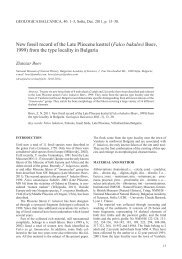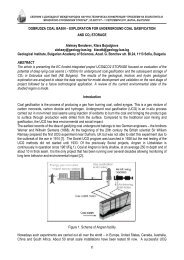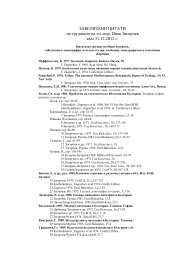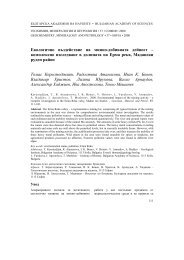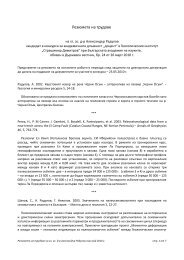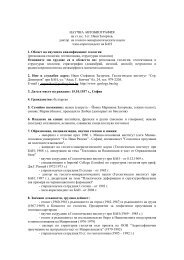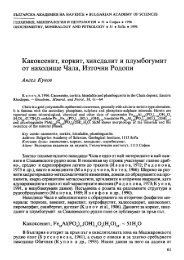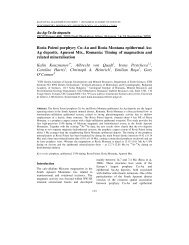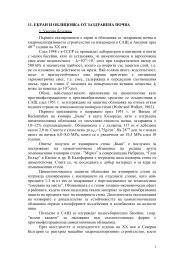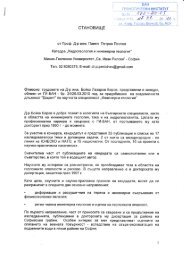Deinotherium thraceiensis sp. nov. from the Miocene near Ezerovo ...
Deinotherium thraceiensis sp. nov. from the Miocene near Ezerovo ...
Deinotherium thraceiensis sp. nov. from the Miocene near Ezerovo ...
You also want an ePaper? Increase the reach of your titles
YUMPU automatically turns print PDFs into web optimized ePapers that Google loves.
8. There are significant differences between <strong>the</strong> three<br />
skulls in <strong>the</strong> occipital region. Os occipitale in D. <strong>thraceiensis</strong><br />
<strong>sp</strong>. n. is high, wide and at an angle of 80°<br />
toward <strong>the</strong> forehead, and of ca. 70° to <strong>the</strong> plane of<br />
<strong>the</strong> teeth. In D. giganteum Kaup <strong>the</strong>se angles are 70°<br />
and 50° corre<strong>sp</strong>ondingly; in D. levius Jourdan <strong>the</strong><br />
declination of <strong>the</strong> occipital bone is even larger, so<br />
<strong>the</strong> angle is only 60°. As a whole, <strong>the</strong> skull of D. levius<br />
Jourdan is very flat and low. Os occipitale is visibly<br />
concave and very wide, forming two lateral wings<br />
(Fig. 6 C and D – OS). Those wings are almost lacking<br />
in D. <strong>thraceiensis</strong> <strong>sp</strong>. n. and in D. giganteum<br />
Kaup <strong>the</strong>y are much less developed.<br />
9. The position of <strong>the</strong> occipital condyles is ra<strong>the</strong>r<br />
different (Figs. 5, 6, and 7 – oc). In D. <strong>thraceiensis</strong><br />
<strong>sp</strong>. n. <strong>the</strong>y are situated in <strong>the</strong> middle and in <strong>the</strong> lower<br />
part of <strong>the</strong> occipital bone, almost <strong>the</strong> same is <strong>the</strong>ir<br />
position in D. giganteum Kaup, and in D. levius Jourdan<br />
<strong>the</strong>y are on <strong>the</strong> upper half of <strong>the</strong> noted bone.<br />
According to Svistun, this permitted <strong>the</strong> animal to<br />
raise its head almost at right angle to its neck, thus<br />
fully using its back curved lower tusks.<br />
10. Worth mentioning is a characteristic peculiarity<br />
of <strong>the</strong> Gussiatin skull lacking in all <strong>the</strong> o<strong>the</strong>rs,<br />
including <strong>the</strong> skull <strong>from</strong> <strong>Ezerovo</strong>. This skull has a<br />
double articulation with <strong>the</strong> mandible. Once by an<br />
articular surface on <strong>the</strong> zygomatic process of <strong>the</strong><br />
temporal bone and <strong>the</strong>n by a second surface on <strong>the</strong><br />
petromastoideum. Between those two surfaces is <strong>the</strong><br />
external meatus of <strong>the</strong> auditory canal. How and<br />
when this second articular surface was used, is<br />
unclear.<br />
After comparing <strong>the</strong>ir anatomy we can see that<br />
deino<strong>the</strong>res could be divided in two groups. One includes<br />
D. giganteum Kaup, D. gigantissimum Stefanescu,<br />
D. <strong>thraceiensis</strong> <strong>sp</strong>. n., D. levius Jourdan and<br />
D. indicus Falconer, which have larger teeth, and <strong>the</strong><br />
second – D. bavaricum H. v. Meyer, D. pentapotamiae<br />
Lydekker and o<strong>the</strong>rs, all with smaller teeth.<br />
As a whole, <strong>the</strong> teeth are ra<strong>the</strong>r similar and differences<br />
are seen mainly in <strong>the</strong> two premolars P 3 and P 4 .<br />
In D. giganteum Kaup P 3 is more rounded on <strong>the</strong><br />
inner side. The two inner ridges are more perpendicular<br />
to <strong>the</strong> outer one. The anterior inner ridge is not<br />
connected with <strong>the</strong> outer and is at an acuter angle to it<br />
than in o<strong>the</strong>r taxa. They almost don’t touch each o<strong>the</strong>r<br />
on <strong>the</strong> inner side. If anything like that is observed in<br />
<strong>the</strong>se <strong>sp</strong>ecies, than it is down at <strong>the</strong> very basis. The<br />
ridges merge when <strong>the</strong>y are worn. The cingulum is<br />
more clearly seen here. It consists of numerous large<br />
and small tubercles on all sides of <strong>the</strong> crown.<br />
No comparison with <strong>the</strong> third premolars of D. gigantissimum<br />
Stefanescu is possible, because <strong>the</strong>y have<br />
been restored after D. giganteum Kaup.<br />
In D. levius Jourdan <strong>the</strong> anterior inner ridge of P 3<br />
is situated diagonally to <strong>the</strong> outer one and touches<br />
it. The posterior one is wider and V-shaped in its<br />
upper part, with a shorter anterior part. It is also diagonal<br />
to <strong>the</strong> outer ridge, but does not touch it.<br />
In D. indicum Falconer <strong>the</strong> inner ridges are some<br />
more diagonally situated, compared to D. giganteum<br />
Kaup, but <strong>the</strong>ir tips do not contact.<br />
D. bavaricum H. v. Meyer has small P 3 s. Their<br />
inner ridges are some more perpendicular to <strong>the</strong> outer<br />
one. This is ra<strong>the</strong>r clear with <strong>the</strong> anterior inner ridge.<br />
The valley between <strong>the</strong>m is wider and deeper.<br />
In D. pentapotamiae Lydekker, D. levius Jourdan<br />
and D. indicum Falconer <strong>the</strong> differences are almost<br />
<strong>the</strong> same, concerning <strong>the</strong> position of <strong>the</strong> two inner<br />
ridges and <strong>the</strong> size of <strong>the</strong> tooth and its cingulum.<br />
The fourth premolar of D. <strong>thraceiensis</strong> <strong>sp</strong>. n. has<br />
inner ridges perpendicular to <strong>the</strong> outer one. The<br />
posterior is narrower and longer. The triangular valley<br />
surrounded by <strong>the</strong> posterior inner wall of <strong>the</strong> outer<br />
ridge and <strong>the</strong> inner wall of <strong>the</strong> posterior ridge is<br />
clearer than in all <strong>the</strong> o<strong>the</strong>r <strong>sp</strong>ecies.<br />
D. gigantissimum Stefanescu has a longer P 4 . Its<br />
transverse ridges are at a larger distance <strong>from</strong> each<br />
o<strong>the</strong>r. Besides, it has a strong cingulum on <strong>the</strong> anterior<br />
and <strong>the</strong> posterior side, lacking in our <strong>sp</strong>ecies.<br />
In D. bavaricum H. v. Meyer P 4 s are smaller and<br />
of a more regular square shape. The transverse ridges<br />
are more distant at <strong>the</strong> inner side of <strong>the</strong> crown,<br />
and <strong>the</strong> valley surrounded by <strong>the</strong>m and <strong>the</strong> outer<br />
ridge is wider and larger.<br />
In D. levius Jourdan <strong>the</strong> posterior inner ridge is<br />
also attached to <strong>the</strong> outer one with its longer posterior<br />
branch.<br />
In D. indicum Falconer and D. pentapotamiae<br />
Lydekker <strong>the</strong> last premolars have a square shape and<br />
are smaller. Their transverse ridges are parallel and<br />
of equal size. The valley between <strong>the</strong>m is larger and<br />
everywhere equally wide.<br />
In <strong>the</strong> M 1 s of D. giganteum Kaup, unlike D. <strong>thraceiensis</strong><br />
<strong>sp</strong>. n., <strong>the</strong> three ridges are almost of equal<br />
size, with an equally developed cingulum on both<br />
sides of <strong>the</strong> valleys, blocking <strong>the</strong>m entirely on <strong>the</strong><br />
outer side. The latter is of significant taxonomical<br />
value.<br />
In D. gigantissimum Stefanescu has a developed<br />
cingulum on <strong>the</strong> outer anterior and on <strong>the</strong> posterior<br />
side of <strong>the</strong> crown, resembling a chain of large tubercles,<br />
closely arranged along <strong>the</strong> end of <strong>the</strong> tooth.<br />
There are no significant differences in <strong>the</strong> structure<br />
of <strong>the</strong> first molars of D. bavaricum H. v. Meyer,<br />
except in <strong>the</strong>ir size.<br />
The o<strong>the</strong>r molars (M 2 and M 3 ) of D. <strong>thraceiensis</strong><br />
are not very different <strong>from</strong> those of <strong>the</strong> o<strong>the</strong>r <strong>sp</strong>ecies.<br />
Mandible. (Pl. III, Fig. 1 and Pl. V).<br />
Like <strong>the</strong> skull, it is entirely preserved. Compared to<br />
<strong>the</strong> size of <strong>the</strong> body, it is not large (measurements in<br />
Table 3). Ramus horizontalis long, high, wide and<br />
laterally slightly flattened. Below P 3 <strong>the</strong>re is a well<br />
shaped double opening – foramen mentale. The<br />
highest point of <strong>the</strong> mandible is at <strong>the</strong> symphysis, it<br />
becomes lower towards <strong>the</strong> posterior end (see Plate<br />
V). Because of this, <strong>the</strong> last molar is not horizontal,<br />
but inclined backwards. Processus angularis is strongly<br />
developed, and fossa masseterica is wide but not<br />
very deep. The most typical feature of <strong>the</strong> animals<br />
belonging to this group is <strong>the</strong> shape of <strong>the</strong> symphysis.<br />
Toge<strong>the</strong>r with <strong>the</strong> tusks, it is curved down and<br />
back. In D. <strong>thraceiensis</strong> <strong>sp</strong>. n. <strong>the</strong> symphysis is solid,<br />
19



